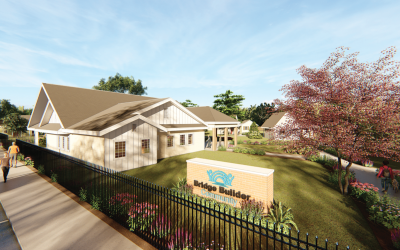However they were formed, these special features of the Carolinas offer rich and vital diversity
By Mac McCall | Photo provided by Linda Lee of SRS
In 1930, as the country descended into the depths of the Great Depression, a Myrtle Beach, S.C.-based lumber company decided to exploit the novel technology of aerial photography and hired Fairchild Aerial Surveys of New York to inventory its holdings. A lone FC-2 cabin monoplane droned over the swamps and fields of Horry County, photographing some 500 square miles of coastal plain. The pilot, eyes glued to his instruments, and the photographer, focused on his craft, failed to notice what lay below them 1.
When the photos were developed, a vast pattern of shallow, elliptical depressions emerged, every single one oriented toward the northwest with eerie consistency, like the aftermath of an artillery barrage. It looked as if a hostile fleet of forgotten antediluvian might had anchored off the breakers of Murrell’s Inlet and pummeled the Carolinas into submission with prehistoric guns. The Carolinas, photographed in black and white from above, resembled the crater-scarred crust of the moon.
The surveyors had stumbled upon what we now call Carolina bays, unique Southern landforms which have remained as enigmatic as they are vital to a variety of Southern flora and fauna. These shallow depressions extend up and down the Atlantic seaboard and litter the surface area of the CSRA’s coastal plain, with over 300 located at Savannah River Site.
Writers of early scientific literature, mesmerized by the consistency and extent of the depressions, jumped to extraterrestrial conclusions and identified a meteorite shower as the bays’ likely origin. Dramatic aerial imagery of this American moonscape, combined with the salacious impact hypothesis, captured popular imagination, culminating in a 1933 article in Harper’s Magazine titled “The Comet that Struck the Carolinas,” which painted a calamitous picture of fiery cataclysm on the Southern seaboard. Today, we know that the probability of an extraterrestrial origin for the bays is slim to none, although the dramatic potholed landscapes that inspired such speculation continue to provoke disagreement and debate.
A comprehensive definition has remained elusive, but certain features are generally agreed upon as collectively identifying the “classic” Carolina bay. Bays are found in the Atlantic Coastal Plain from the Delmarva Peninsula to northern Florida, with the highest concentrations in the Carolinas. They’re elliptical, with their long axis running from the northwest to southeast. Size is highly variable, ranging from less than an acre to over 9,000 acres. The depressions are shallow and typically have elevated sand rims, which are strongest on their southeast sides. Most bays are wetlands with fluctuating water levels, although a few are spring-fed lakes. In fact, the “bay” name is not a reference to water at all, but rather the numerous bay trees which grow in the depressions. Counting bays becomes a semantic and technical circus due to disagreements over what features constitute true bays and the difficulty of adequately cataloging very small depressions, although recent estimates center in the 30,000-50,000 range.
Dozens of hypotheses, some wonderfully far-fetched, have been proposed to account for the origin of the bays. A few have included spawning fish under the prehistoric seas, an antimatter collision with Earth (my personal favorite), and even launching pads for extraterrestrial spacecraft. The comet/meteorite impact proposition mentioned earlier was popular from day one. Later science conclusively determined that the depressions were not attributable to direct impacts, and consensus settled upon a complex array of factors for the initial formation of the depressions, which were then molded into their characteristic shapes by prevailing winds and wave forces.
However, the dramatic pattern formed by the bays speaks to many people on a visceral level and demands an explanation more meaningful than these benign and gradual forces — it stimulates that same conspiratorial nerve in the American mind which will not allow the Kennedy assassination to flutter into the dustbin of history. Consequently, the extraterrestrial hypothesis still lives a vibrant life in the minds of internet sleuths. Proselytizers of the faith industriously propagate their theories online, some now suggesting that a comet impact near the Great Lakes hit an ice sheet, producing giant chunks of ejecta that then created the Carolina bays.
While scientists are in near-universal agreement that the bays owe their shape and orientation to water and wind, much else about the bays remains shrouded in disagreement, if not mystery. There’s uncertainty over not just the mechanism for the original formation of the depressions, but also their age, which is currently believed to be anywhere between 10,000 and 250,000 years.
All of this is so much desultory hominid babbling to the plants and animals that call Carolina bays home. That’s what is truly clear about the bays — they are crucial for diversity, constituting “islands” of high species richness in the coastal plain. The Savannah River Ecology Laboratory at SRS has conducted decades of research on the ecology of the bays and holds heavyweight status when it comes to literature in this field. Research professional Linda Lee of SREL kindly agreed to speak to me, although she defers to the late Rebecca Sharitz as SRS’ expert on the subject. Sharitz is present here through her prolific writing, which has highly influenced and assisted my research.
Carolina bays are ecologically significant because of their isolation from other water sources. As perched water tables, they “characteristically have no natural surface drainages into or from them, and overland surface flows are minimal.” 2 Water levels are therefore primarily regulated by precipitation and evapotranspiration, varying both seasonally and among years with different rainfall patterns. This temporal variation occurs in addition to the vast differences between individual bays, resulting in a wonderful spectrum of wet, partially inundated and dry habitats.
This “temporal and spatial variation in hydrology” allows a multitude of plant communities to flourish within the bays, ranging from cypress swamps to pine woodlands, depression swamps, vernal pools, bay forests and many more. In fact, seed banks measured in bays at SRS are the richest of any reported in freshwater habitats across the globe. 3 These teeming underground reservoirs of diversity primarily manifest themselves over time, with different plant species sprouting in response to “variable and unpredictable hydrologic conditions” in the bays 4.
Demonstrating this temporal diversity, Lee recalls visiting Dry Bay at SRS, which was almost exclusively covered in maidencane at the time. She grabbed a handful of soil, spread the dirt onto a tray, and then watched over several weeks as a thick carpet of diverse sedges grew forth from the slumbering seed bank. Many of the species found in bays are rare — around 200 by Lee’s estimate — a significant number of which are legally protected. They constitute a collection of some of the most beautiful and fascinating flora the southeastern U.S. has to offer, including carnivorous plants like sundews. Among Lee’s favorite bay denizens is Rhexia aristosa, a slender violet flowerlet which will flourish in certain bays in the summer. As she describes it, walking through a bay of these is “like stepping into the pages of Bartram’s Travels.”
Animals rely upon the bays as well, drawn by the fluctuating water levels that often leave bays dry for parts of the year. This intermittent dryness precludes the presence of fish populations, allowing organisms to flourish that are otherwise subjected to predation by them. Of 34 amphibians occurring on SRS, 16 depend solely on these bays and related depressions for breeding. 5 The sheer numbers are mind-boggling. In a single-year study on two SRS bays under 1 acre in size, 72,000 amphibians were counted coming to and from the water. 6 The last populations of gopher frogs in South Carolina are found in bays as well. Beyond amphibians, the bays provide refuge and habitat to a diverse roster of other creatures — in fact, SRS bays have the highest zooplankton richness of any temporary wetlands ever surveyed.
Sadly, these oases of diversity have suffered heavily in the face of advancing European settlement since the 1800s. Farmers were the first to clash with the bays, draining and tilling what they perceived as nuisance wet spots. As farmland receded and suburban sprawl has continued to grow, commercial and residential development pose greater threats than agricultural practices. 7 One survey estimated that of all Carolina bays greater than 2 acres in South Carolina, 97% have been disturbed, and similar studies in Georgia have noted corresponding degrees of degradation. 8 At SRS, restoration has been conducted by plugging drainage ditches and harvesting trees — “restore the environmental conditions, and nature will do a lot of the work.” Locally, SRS is a powerful engine for the conservation of bays, but many threatened features exist on private properties across the CSRA as well.
If you’re aware of a Carolina bay on your property and interested in taking steps to protect it, please feel free to reach out to me and I’ll be happy to put you in touch with local expertise. Healthy bays act as superchargers for the already rich biodiversity of the coastal plain, allowing our upland areas to support far more species than they would otherwise. Add to this their status as an enigmatic and uniquely Southern landform, and it’s hard to imagine something more worthy of preservation.
Appears in the July 2020 issue of Augusta Magazine.






